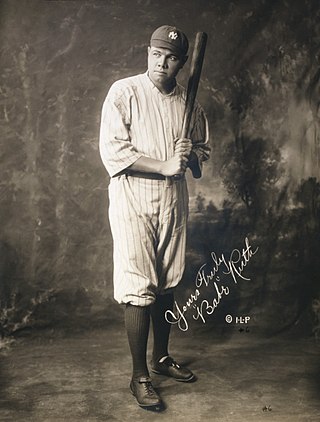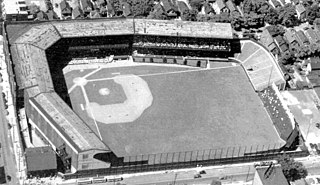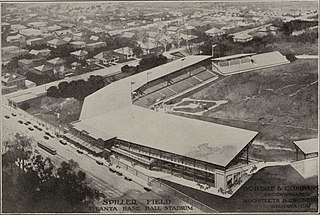
George Herman "Babe" Ruth was an American professional baseball player whose career in Major League Baseball (MLB) spanned 22 seasons, from 1914 through 1935. Nicknamed "the Bambino" and "the Sultan of Swat", he began his MLB career as a star left-handed pitcher for the Boston Red Sox, but achieved his greatest fame as a slugging outfielder for the New York Yankees. Ruth is regarded as one of the greatest sports heroes in American culture and is considered by many to be the greatest baseball player of all time. In 1936, Ruth was elected into the Baseball Hall of Fame as one of its "first five" inaugural members.

The original Yankee Stadium was located in the Bronx in New York City. It was the home of the New York Yankees from 1923 to 2008, except for 1974–1975 when it was renovated. It hosted 6,581 Yankees regular season home games during its 85-year history. It was also the home of the New York Giants National Football League (NFL) team from October 21, 1956 through September 23, 1973. The stadium's nickname is "The House That Ruth Built" which is derived from Babe Ruth, the baseball superstar whose prime years coincided with the stadium's opening and the beginning of the Yankees' winning history.

Wrigley Field was a ballpark in Los Angeles, California. It hosted minor league baseball teams in the region for more than 30 years. It was the home park for the minor league Los Angeles Angels during their run in the Pacific Coast League, as well as for the inaugural season of the major league team of the same name in 1961. The park was designed by Zachary Taylor Davis, who had previously designed both of the Major League Baseball stadiums in Chicago: Comiskey Park and Wrigley Field. The ballpark was also used as the backdrop for several Hollywood films about baseball, as well as the 1960 TV series Home Run Derby.

The Polo Grounds was the name of three stadiums in Upper Manhattan, New York City, used mainly for professional baseball and American football from 1880 through 1963. The original Polo Grounds, opened in 1876 and demolished in 1889, was built for the sport of polo. Bound on the south and north by 110th and 112th streets and on the east and west by Fifth and Sixth (Lenox) avenues, just north of Central Park, it was converted to a baseball stadium when leased by the New York Metropolitans in 1880.

Sick's Stadium, also known as Sick's Seattle Stadium and later as Sicks' Stadium, was a baseball park in the northwest United States in Seattle, Washington. It was located in Rainier Valley, on the NE corner of S. McClellan Street and Rainier Avenue S. The longtime home of the Seattle Rainiers of the Pacific Coast League (PCL), it hosted the expansion Seattle Pilots during their only major league season in 1969.

Cleveland Stadium, commonly known as Municipal Stadium, Lakefront Stadium or Cleveland Municipal Stadium, was a multi-purpose stadium located in Cleveland, Ohio. It was one of the early multi-purpose stadiums, built to accommodate both baseball and football. The stadium opened in 1931 and is best known as the long-time home of the Cleveland Indians of Major League Baseball (MLB), from 1932 to 1993, and the Cleveland Browns of the National Football League (NFL), from 1946 to 1995, in addition to hosting other teams, other sports, and concerts. The stadium was a four-time host of the Major League Baseball All-Star Game, one of the host venues of the 1948 and 1954 World Series, and the site of the original Dawg Pound, Red Right 88, and The Drive.

League Park was a baseball park located in Cleveland, Ohio, United States. It was situated at the northeast corner of Dunham Street and Lexington Avenue in the Hough neighborhood. It was built in 1891 as a wood structure and rebuilt using concrete and steel in 1910. The park was home to a number of professional sports teams, most notably the Cleveland Indians of Major League Baseball. League Park was first home to the Cleveland Spiders of the National League from 1891 to 1899 and of the Cleveland Lake Shores of the Western League, the minor league predecessor to the Indians, in 1900. From 1914 to 1915, League Park also hosted the Cleveland Spiders of the minor league American Association. In the late 1940s, the park was also the home field of the Cleveland Buckeyes of the Negro American League.

National League Park, commonly referred to as the Baker Bowl after 1923, was a baseball stadium and home to the Philadelphia Phillies from 1887 until 1938, and first home field of the Philadelphia Eagles from 1933 to 1935. It opened in 1887 with a capacity of 12,500, burned down in 1894, and was rebuilt in 1895 as the first ballpark constructed primarily of steel and brick, and first with a cantilevered upper deck.

Braves Field was a baseball park located in Boston, Massachusetts. Today the site is home to Nickerson Field on the campus of Boston University. The stadium was home of the Boston Braves of the National League from 1915 to 1952, prior to the Braves' move to Milwaukee in 1953. The stadium hosted the 1936 Major League Baseball All-Star Game and Braves home games during the 1948 World Series. The Boston Red Sox used Braves Field for their home games in the 1915 and 1916 World Series since the stadium had a larger seating capacity than Fenway Park. Braves Field was the site of Babe Ruth's final season, playing for the Braves in 1935. From 1929 to 1932, the Boston Red Sox played select regular season games periodically at Braves Field. On May 1, 1920, Braves Field hosted the longest major league baseball game in history: 26 innings, which eventually ended in a 1–1 tie.

The Seattle Rainiers, originally named the Seattle Indians and also known as the Seattle Angels and, during 1919, the Seattle Purple Sox, were a Minor League Baseball team in Seattle, Washington, that played in the Pacific Coast League from 1903 to 1906 and 1919 to 1968. They were initially named for the indigenous Native American population of the Pacific Northwest, and changed their name after being acquired by the Rainier Brewing Company, which was in turn named for nearby Mount Rainier.
Ruppert Stadium was a baseball stadium in Newark, New Jersey, in the area now known as the Ironbound.

Ponce de Leon Park ( PONSS də LEE-ən; also known as Spiller Park or Spiller Field from 1924 to 1932, and "Poncey" to locals, was the primary home field for the minor league baseball team called the Atlanta Crackers for nearly six decades. The Crackers played here in the Southern Association and the International League. It was also home of the Atlanta Black Crackers who captured the second half championship of the Negro American League in 1938.

Albert George Cole was an American baseball pitcher.

The Year Babe Ruth Hit 104 Home Runs is a 432-page non-fiction book by Bill Jenkinson published by Carroll & Graf Publishers in March 2007. The title refers to Jenkinson's conclusion that in modern ballparks under modern rules, Ruth would have hit 104 home runs in 1921, 90 in some other seasons, and over 60 many times. The author's research concludes that Ruth would have hit well over a thousand home runs in his career.
The 1935 Major League Baseball season was contested from April 16 to October 7, 1935. The Chicago Cubs and Detroit Tigers were the regular season champions of the National League and American League, respectively. The Tigers then defeated the Cubs in the World Series, four games to two.
Browning Park is a park in Moline, Illinois, United States, located at 16th Street and 23rd Avenue. Browning Field has been the home of high school and professional athletic events since 1910. It has hosted athletes such as Babe Ruth and Red Grange.

Ban Johnson Park was a baseball stadium located in Hot Springs, Arkansas. It was also known as Whittington Park and McKee Park. The ballpark was located within today's Whittington Park Historic District and directly across from the still active Arkansas Alligator Farm and Petting Zoo.

Athletic Park was a sports facility in Vancouver, British Columbia, Canada mainly used for baseball but also hosted soccer, football, lacrosse, bike races, and rallies.














